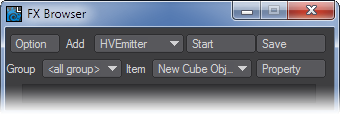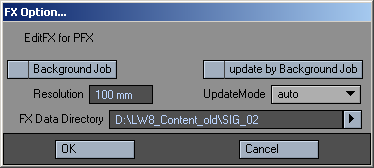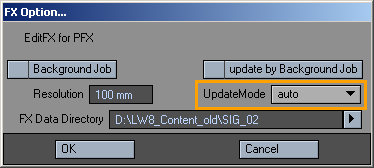Additional Dynamics Utilities
Deleting an FX controller
Select and clear, just as you would any other Layout item (Items > Clear Selected Item).
To open a controller’s property panel:
Choose the controller from the Item pop-up menu and click the Property button to open the Properties Panel for the selected controller.
You can also display the Property Panel for the currently selected controller by choosing Utilities > FX_Property or by accessing the Dynamics Tab in the Object Properties Panel.
The Start Button
Some effects require a “pre-calculation” before they can be previewed in your animations. These are instances where you have particles interacting or have post-deformed geometry. By activating the Start button, the FX will begin solving any simulations that are currently setup in the scene. The progress of the simulation is displayed in an output pane that opens at the bottom of the FX Browser when the Start button is activated. A shortcut to this is on Layout’s toolbar at Modify > IKB Calculate.
Dynamics Window during calculation
Many scenes don’t need this step, but clicking Start won’t do any harm if you are unsure.
The Save Button
Clicking the Save button saves all controller motions, using individual files, to your FX directory (defined on the Option dialog). These can be loaded using the Load Motion option on the Controllers Properties Panel.
Options Dialog
The Options dialog has some options that affect the manner in which LightWave computes controllers.
The Background Job option activates multithreading. The update by Background Job option will update Layout when background tasks are complete. In most cases, you should leave these options in their default state of off.
The Resolution setting adjusts the parameter used when performing the physics simulations. The smaller the Resolution setting is, the more accurate the simulation will be. However, this also has a direct effect on the rendering times.
In this dialog you can also set the FX Directory. This is the default directory used when saving Controller settings.
Real-time Display
Just click the Play button in Layout and as you tweak the various controller parameters, you get real-time updates of how your changes affect the particles.
: Scenes with particles interacting or with post-deformed geometry require you to click the Start button first to pre-compute some motions. Clicking Start won’t do any harm if you are unsure.
You can control how FX Controllers are updated using the UpdateMode pop-up menu.
Auto updates all emitters as parameters are modified. Use this for fast systems or in low-particle count simulations.
If you have multiple emitters and are using the Select update, then only the emitter showing in the Select pop-up menu, if any, will be updated.
Adaptive dynamically scales the number of visible particles based on your CPU performance. This setting attempts to keep interactive performance at a useful level.
User turns off particle updating completely. You may force an update by either clicking the Start button on the Particle FX Browser, or the Update button on the File Tab of the Emitter Controller Panel. This setting is useful in situations with heavy particle counts.
Groups
You can group Dynamic objects with a user-defined name to prevent unwanted interaction.
This also works with Particle FX controllers. This becomes very handy when you are working on a complex scene and you want certain Wind emitters to only affect certain objects.
<All Group> Includes all groups.<default> Includes all items in scene.<new group> Create individual group. Can associate functions within a group.
You can associate with particle FX’s functions using group function. If it is in the same group, you can associate settings. Also, if you do not want to associate, just by removing from the group, you can disregard the association.



